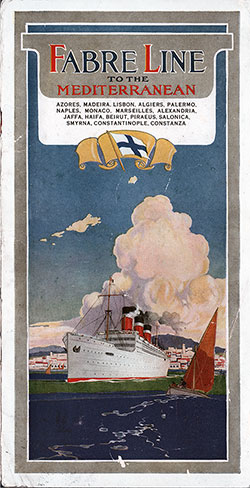SS Alesia Passenger Lists 1930

The Fabre Line Steamer SS Alesia (1906) in 1928. GGA Image ID # 1d18ea1593
All Digitized Passenger Lists For the SS Alesia Available at the GG Archives. Listing Includes Date Voyage Began, Steamship Line, Vessel, Passenger Class and Route.

1930-06-19 SS Alesia Passenger List
Steamship Line: Fabre Line
Class of Passengers: Cabin Class
Date of Departure: 19 June 1930
Route: New York and Providence, RI to Ponta Delgada, Madeira, Piraeus, Salonica (Thessaloniki), Constantinople (Istanbul), Constanza (Romania?), Jaffa (Haifa), Beirut, and Marseilles
Commander: Captain Edmond MacQuin
Notable Passengers: Dr. Bennett F. Avery, Prof. Douglas L. Buffman, Rev. Charles D. Brokenshire, and Captain B. W. Venable.
Passenger Lists contained in the GG Archives collection represent the souvenir list provided to the passengers of each cabin class (and other classes). Many of these souvenir passenger lists have disappeared over the years. Our collection contains a sampling of what was originally produced and printed by the steamship lines.
Recap and Summary of the SS Alesia Passenger Lists (1930)
The SS Alesia (1906) was a Fabre Line steamship that played a significant role in transatlantic and Mediterranean travel during the early 20th century. Operating under French registry, the Fabre Line was a key player in connecting North America with Southern Europe, the Middle East, and North Africa—offering both passenger and cargo services.
The only documented passenger list from 1930 in the GG Archives collection provides a fascinating look into a unique long-distance itinerary, transporting travelers from New York and Providence, RI, to an impressive range of Mediterranean and Middle Eastern ports.
Most Interesting Passenger List from 1930
📜 June 19, 1930 – An Extraordinary Mediterranean and Middle Eastern Voyage
📌 Why is this voyage particularly fascinating?
- Unlike typical transatlantic crossings, this voyage had a remarkable itinerary spanning both the Atlantic and Mediterranean:
- New York and Providence, RI – Departure points in the U.S.
- Ponta Delgada (Azores) – A critical stop for Portuguese immigrants and a well-known refueling station.
- Madeira (Portugal) – A popular luxury tourist destination.
- Piraeus (Greece) – The gateway to Athens and classical Greece.
- Salonica (Thessaloniki, Greece) – A culturally rich city with a major Jewish population and a significant Ottoman history.
- Constantinople (Istanbul, Turkey) – A strategic Eurasian hub with deep historical significance.
- Constanza (Romania?) – Likely referring to Constanța, a major Romanian port on the Black Sea, an entryway into Balkan Europe.
- Jaffa (Haifa, Palestine) – A vital destination for Jewish and Christian pilgrims, particularly during the British Mandate period.
- Beirut (Lebanon) – A key cultural and trade center of the Levant.
- Marseilles (France) – The final European port, where many passengers would connect to rail services or continue their journeys across Europe.
This multi-stop itinerary showcases the SS Alesia’s role in not just transatlantic travel, but in complex Mediterranean and Middle Eastern routes, which were rare for many steamship lines.
🔎 Notable Passengers
📌 Why are these passengers significant?
This passenger list includes a diverse range of professionals, including scholars, religious figures, and military personnel, hinting at cultural, religious, and academic exchanges between the U.S. and Europe/Middle East:
- Dr. Bennett F. Avery – Likely a physician or scientist, indicative of medical exchanges or research expeditions.
- Prof. Douglas L. Buffman – Suggests an academic mission, possibly archaeology or history given the destinations.
- Rev. Charles D. Brokenshire – A religious leader, probably traveling for missionary or pilgrimage purposes in the Holy Land and Eastern Mediterranean.
- Captain B. W. Venable – A military or maritime figure, which could point to naval interests or colonial administration affairs.
These names suggest that the SS Alesia was transporting an elite group of passengers, involved in research, religious missions, and diplomatic or military affairs.
Historical Significance of the SS Alesia Passenger List
1. A Rare Example of a Transatlantic–Mediterranean Hybrid Route
- Unlike the major Atlantic liners focused solely on New York–Liverpool or New York–Le Havre crossings, this voyage extended deep into the Mediterranean and the Middle East.
- A mix of passengers likely traveling for education, research, diplomacy, and religious missions, making it one of the most diverse passenger lists of its time.
2. A Window Into Mediterranean and Middle Eastern Travel in 1930
- The ports of call reflect the shifting political landscape of the time:
- Palestine (British Mandate) – Increasing Jewish immigration leading up to World War II.
- Turkey (New Republic) – Just a few years after the fall of the Ottoman Empire.
- Lebanon (French Mandate) – A growing intellectual and cultural center.
3. The Role of Fabre Line in Niche Travel Markets
- The Fabre Line was not as large as Cunard or White Star but played a key role in servicing routes often overlooked by the bigger lines.
- The inclusion of Providence, RI, as a departure port suggests the presence of Mediterranean immigrant communities in New England who used the line for return voyages.
Conclusion: Why This Passenger List Matters
🔹 A Unique and Historically Rich Route – The Alesia’s 1930 voyage connects North America with some of the most historically significant cities in Europe and the Middle East, making it a rare and valuable document for historians and researchers.
🔹 A Glimpse Into Transatlantic Academic, Religious, and Diplomatic Travel – With professors, doctors, clergy, and military figures on board, this list suggests the importance of steamship travel in facilitating global scholarly and religious missions.
🔹 A Record of a Bygone Era – Many of the political and colonial landscapes of these destinations would change dramatically within a decade, making this one of the last voyages to experience the Mediterranean world before World War II reshaped international travel.
The SS Alesia’s 1930 passenger list is more than just a record of a journey—it is a snapshot of a world in transition, where education, diplomacy, and faith intertwined on the high seas.
